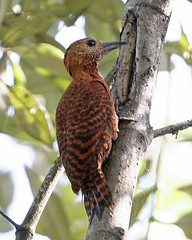Plainspoken Coffee. A Coffee Review for Ordinary People by Ordinary People, #37.
As noted in the the post with background information on coffee growing in Colombia, finding a notably tasty, really sustainable coffee from Colombia is still not incredibly easy. There are a couple of choices for those concerned with migratory and resident bird habitat preservation. One includes coffees that are often known as “Cerulean Warbler” coffees. Thanksgiving Coffee Company imports and roasts one on behalf of the American Bird Conservancy which was reviewed here (includes background links).
The other option is Mesa de los Santos, a farm that is certified organic, Rainforest Alliance, and Smithsonian Bird-Friendly. We reviewed this coffee from Counter Culture here, but it is one of the most widely available Bird-Friendly coffees on the market. Just Google it and you can get your hands on some pronto.
One roaster doing a great job of sourcing small lot, specialty coffee in Colombia is George Howell’s Terroir Coffee. We recently tried a selection from Terroir, El Descanso. Terroir has run out of the 2007 crop reviewed here, but they will have a new crop available in October 2008.
 El Descanso comes from the 8 hectare farm of Jesus Orlando Lopez, at 1700 meters in southwestern Huila. Terroir indicates this is of the caturra variety, although Sweet Maria’s Tom Owen notes (in the pages indicated below) that the farmer is using the castillo variety in his new plantings.
El Descanso comes from the 8 hectare farm of Jesus Orlando Lopez, at 1700 meters in southwestern Huila. Terroir indicates this is of the caturra variety, although Sweet Maria’s Tom Owen notes (in the pages indicated below) that the farmer is using the castillo variety in his new plantings.
This farm won 12th place in the 2006 Cup of Excellence. At the time, it was indicated that the coffee was sun-grown. However, the Terroir web site notes that El Descanso is being reforested and applying for Rainforest Alliance certification. The bag came with the RA seal on it; I don’t see it specifically listed on the RA site, but there are many producers listed for Huila in a sort of generic form and El Descanso may be included in one of those listings.
 In addition to coffee Sr. Orlando Lopez has plots of yuca, sugar cane, and beans, and a couple of pastures. The “rastrojo reserva” is, I believe, set aside for compost or mulch, or may be a fallow field.
In addition to coffee Sr. Orlando Lopez has plots of yuca, sugar cane, and beans, and a couple of pastures. The “rastrojo reserva” is, I believe, set aside for compost or mulch, or may be a fallow field.
The tasters all really enjoyed this coffee, which was obviously a step beyond the ideal Colombian profile. The aroma was distinctive, and our amateur noses couldn’t quite pin it down. Suggestions included honey, fresh baked caramel buns, and yogurt-covered pretzels. Like some of the best and brightest Central American coffees, it had a lovely almost citrus “zing” on the first piping-hot sip. Citrus and honey were again mentioned, as were faint cherry, blackberry, ripe plum or yellow plum (leading to an off-topic discussion of the difficulty in obtaining truly good plums around here). It remained sweet as it cooled, with candy and chocolate notes moving to the forefront.
 We really enjoyed this coffee, and felt it was a great example of what the best Colombian coffees have to offer. We gave it 3.5 motmots.
We really enjoyed this coffee, and felt it was a great example of what the best Colombian coffees have to offer. We gave it 3.5 motmots.
Our next review will be a very nice Colombian that is also Rainforest Alliance certified, always available, and easy to obtain!
 Green coffee and home roasting supplier Sweet Maria’s has formalized their direct trade buying program, calling it Farm Gate Coffee. Farm Gate prices are at least 50% (but often 100% or more) over Fair Trade prices. Their latest newsletter gives a more thorough explanation.
Green coffee and home roasting supplier Sweet Maria’s has formalized their direct trade buying program, calling it Farm Gate Coffee. Farm Gate prices are at least 50% (but often 100% or more) over Fair Trade prices. Their latest newsletter gives a more thorough explanation.






